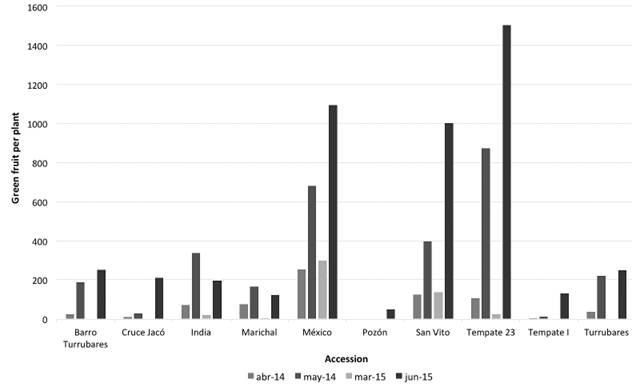Introduction
The Jatropha crop has received increasing attention in recent years, due to the fact that it is one of the plant species with the highest oil yield (55% content within the seed), from which a high-quality biodiesel can be obtained. It is possible to achieve yields of approximately 2,500 kilograms of seed/hectare (1). It is a Monoecius perennial plant species from the Euphorbiaceae family which produces a relatively low number of female flowers, which restricts the number of seeds which can be harvested (2). It is a native Mesoamerican perennial shrub that is grown in the tropics and subtropics of diverse regions, and is adapted to soils with low fertility (3). Due to its ability to develop in semi-arid and marginal areas, jatropha is also used to control erosion. Jatropha can be considered as an agricultural alternative that can be managed and exploited for the reduction of poverty and the development of employment in rural areas, since it assists in optimizing manpower and soil use (4).
In Costa Rica, researchers from the Fabio Baudrit Research Station (Universidad de Costa Rica) of the Instituto Tecnológico de Costa Rica and the Universidad Nacional have studied different endangered native species, and have encouraged communities and associations of producers to become involved in the rescue and reproduction of plant species in their communities to obtain the maximum benefits from crops through the exploitation of value-added properties of products and sub-products generated by adequate crop management. Jatropha curcas (jatropha) is a promising candidate for such efforts, but since it has not been domesticated, considerable research efforts must be undertaken to determine the geographic, crop management, and yield conditions that will allow the best commercial exploitation of the crop. As a result of these initial steps, and because of the agro-energetic properties of this crop, a germplasm bank was established at the Estación Experimental Fabio Baudrit, which currently has 52 accessions from Costa Rica, as well as from Brazil, Mexico, and India, all of which are provided with the appropriate edaphoclimatic conditions (250 to 600 mm of rainfall/year and 20-28 °C) that, along with their adaptability, allow them to grow well (1). It is highly important for countries to have germplasm banks available to preserve the diversity of species such as Jatropha curcas and maintain their rich phylogenies (5). To characterize their reproductive behaviors and use them in future genetic improvement programs, a comparative study of the different accessions was carried out, using inflorescence and female flower and fruit production as variables, and analyzing correlations between these factors and climatic conditions.
Materials and methods
In the Estación Experimental Fabio Baudrit (UCR) research facility, located in Alajuela, Costa Rica, a jatropha germplasm bank was established with 52 accessions which were morphologically and molecularly characterized. This bank was established in 2009 and relocated in 2010. The soil was prepared mechanically (racked, ploughed and hillocked). A spacing of 3 x 2 m was left between plants, which were irrigated once a week. Glyphosate and mechanical weeding with a scythe were used for weed control. Although there were very few problems related to diseases and infestations, a copper oxychloride fungicide was applied.
As part of the Project “Generación de información técnico-científica para el desarrollo del cultivo de Jatropha curcas (Tempate) en Costa Rica para su uso como fuente de energía alternativa y mitigación del cambio climático” (Generation of technical-scientific information for the development of Jatropha curcas (Tempate) in Costa Rica, to be used as an alternative energy source and for mitigation of climate change) (6), the accessions were morphologically characterized. Based on the results, 3 individuals were selected from each of the 10 most productive accessions, identified as: Turrubares JCCR36, Jacó JCCR-3, El Barro de Turrubares, JCCR-43, Orotina JCCR-1, Marichal JCCR-42, Tempate 1 JCCR-6, San Vito 2 JCCR-30, México 2 JCCR-31, India JCCR-27, and Tempate 1-Guanacaste JCCR-23. The 30 plants selected were monitored every week from February 2014 through June, 2015. The number of inflorescences, open female flowers per inflorescence, and green fruits were counted every week.
The period with the highest yield of green fruits, inflorescences and female flowers for the first and second semesters of 2014 and 2015 was used for this assay. A non-parametric Kruskal Wallis analysis was carried out to assess differences between accessions; since the data was not normally distributed, it was not standardized. The tests were performed with a significance of 0.05 using STATISTICA 9.0. statistical software.
The yields of accessions were evaluated using the Index of Plant Productivity (IPP) based on the multi-production assumptions presented by Fumero et al. (7), and analysis of leaf productivity of six species in different climatic conditions (8). The values of the IPP are expressed in percentage ranging between 0 and 100, with higher values indicating higher yields.

Where: IFN is the number of inflorescences at a given moment N; IFn max is the maximum number of inflorescences at moment N; FFN is the number of female flowers at a given moment N, FFn max is the maximum number of female flowers at a given moment N; FVN is the amount of green fruits at moment N, and Fvn max is the maximum amount of green fruits at moment N.
Montaldo (9), and Navarro et al. (10), determined reproductive efficiency based on the relationship between the number of flowers and the number of fruits produced. The annual reproductive success (viability) of female flowers was calculated by dividing the total number of female flowers by the total number of green fruits per year. Therefore, the annual viability of female flowers was calculated by dividing the total number of female flowers by the total number of green fruits per year. The tests were performed with a 0.05 significance level using the statistical software STATISTICA 9.0.
The values for production of female flowers and inflorescences were correlated with rainfall, temperature and solar radiation measurements, and a correlation of more than 0.40 was regarded as significant.
Results and discussion
Using the data gathered through the phenological assessment, the average quantity of inflorescences per plant was calculated for each accession. The San Vito accession showed the highest average inflorescence production per plant, exceeding other accessions such as Mexico and Tempate 23 (figure 1).
The results of Kruskal-Wallis non-parametric analyses presented in table 1, show that in the month of March, 2014, the accessions with the highest production of inflorescences were Mexico and San Vito, but there is no evidence of significant differences among the accessions from Barro Turrubares, Turrubares, Marichal and Tempate 23. In the analysis performed for inflorescence production in September of 2014, no significant difference was observed within the same accessions, including the India accesion. However, when the same analysis is performed for inflorescence yields in the months of February and May of 2015, significant differences were found between the Mexico and San Vito accessions, while for May of 2015, these accessions were not significantly different from Tempate 23, but were different from the rest of the accessions (table 1).
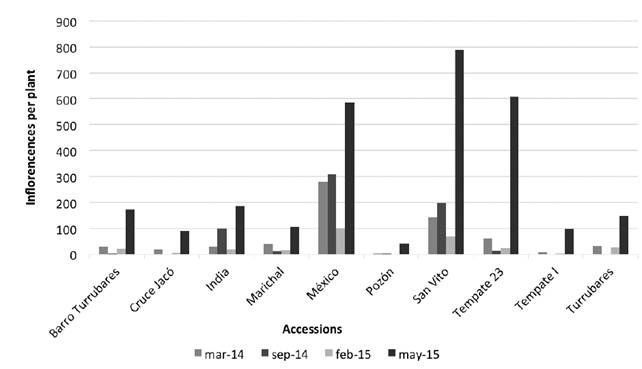
Figure 1 Average inflorescences per plant for each accession, obtained during the 2 years of monitoring
Table 1 Kruskal-Wallis non-parametric analysis of the number of inflorescences per accession per hectare in four different production periods.
| Accesión | mar-14 | sep-14 | feb-15 | may-15 |
| Pozón | 1067 A (1848) | 4800 A (4233) | 0 A (0) | 65067 A (107204) |
| Tempate 1 | 12267 A (18544) | 0 AB (0) | 3733 A (6466) | 153067 A (87436) |
| Cruce Jacó | 29333 AB (40011) | 0 ABC (0) | 6933 A ( 9375) | 144000 A (84987) |
| India | 45867 ABC (64802) | 157867 ABCD (273433) | 29333 A (29343) | 298667 A (352604) |
| Barro Turrubares | 46400 ABCD (39224) | 3200 ABCD (3200) | 34667 A (30484) | 277333 A (92456) |
| Turrubares | 52800 ABCD (42962) | 0 BCD (0) | 40000 A (51431) | 235733 A (16343) |
| Marichal | 62400 ABCD (27759) | 20267 BCD (21723) | 26667 A ( 14551) | 169067 A (83267) |
| Tempate 23 | 97067 BCD (8812) | 23467 CD (541326) | 37867 A (331) | 972800 AB (435632) |
| México | 449067 D (476854) | 492800 D (748897) | 163200 B (140827) | 937067 B (688423) |
| San Vito | 226667 D (75900) | 314133 D (54132) | 107733 B (37261) | 1261333 B (1043741) |
| Letras iguales significa que no hay diferencias significativas entre accesiones | ||||
No significant differences between accessions for cells with the same letters.
The data summarized in figure 2 show that the accessions with the highest amount of female flowers were Mexico, Tempate 23 and San Vito, which produced between 590 and 900 female flowers, in 2015 (tres accessions, 2 valores; no puede usarse “respectivamente”). Comparing these results to those shown in figure 1, inflorescence production correspond to the same same accessions.
When performing the non-parametric analyses, to determine if there were significant differences between the selected accessions, the results presented in table 2 for the period of higher yields in 2014 show that there were significant differences between the accessions San Vito, Tempate 23, Mexico and the rest of the accessions; these differences are more notable in 2015, when inflorescence and female flower yields doubled from 2014 to 2015. Statistically, these three accessions are significantly higher than the remaining seven in terms of female flower production. According to a bibliographical review (11) the plant reaches its maximum production level after six years.
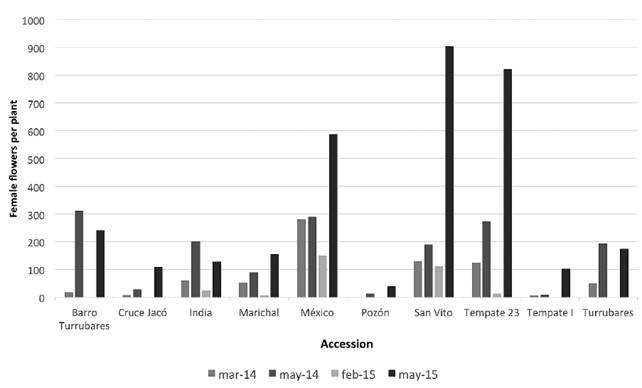
Figure 2 Female flower production per plant in the jatropha accessions at different times during the phenological assessment.
As expected, the presence of a higher amount of fruits is associated with higher female flower production. Hence, figure 3 shows that the accessions Tempate 23, Mexico and San Vito are those with the highest amount of fruits/plant/period. The San Vito accession produced a large quantity of inflorescences (figure 1) and female flowers (figure 2), but these were not as viable as Tempate 23, the accession with the highest fruit yield (figure 3).
Table 2 Kruskal-Wallis non-parametric analyses of the number of female flowers produced per accession, per hectare, in four different production stages.
| Accession | Mar-14 | Sep-14 | Feb-15 | May-15 |
| Pozón | 0 A (0) | 20800 C (275132) | 0 A (0) | 61333 A (92722) |
| Tempate I | 74677 C (9098) | 13333 A (23094) | 0 A (0) | 163200 B (22228) |
| Cruce Jacó | 10133 A (17551) | 45333 AB (78520) | 0 A (0) | 173333 B (55893) |
| India | 94400 ABC (147191) | 320533 BC (108048) | 39467 B (68358) | 205333 B (300376) |
| Barro Turrubares | 29333 AB (37807) | 98133 C (160131) | 0 A (0) | 386133 B (35967) |
| Turrubares | 78400 ABC (96013) | 308800 C (22565) | 0 A (0) | 277867 B (89719) |
| Marichal | 84800 ABC (62400) | 144000 ABC (121062) | 9600 B (9600) | 246933 B (176620) |
| Tempate 23 | 201067 C (60044) | 435200 C (350108) | 19733 B (34179) | 1314667 C (484497 |
| México | 450667 C (447549) | 463467 ABC (121062) | 239467 B (302469) | 938667 C (563512) |
| San Vito | 208000 BC (85969) | 305067 BC (35967) | 176533 C (305469) | 1444800 C (1168158) |
No significant differences between accessions for cells with the same letters.
The behavior of inflorescences, female flowers, and fruit production behavior was similar in the different time periods studied. As expected, the presence of a greater number of female flowers was associated with greater fruit production. The difference between accessions was not as evident in 2014 as it was in June 2015, where the Tempate 23 and Mexico accessions considerably exceeded the production of other accessions; in the rest of the months studied, the differences were not as large (table 3).
Table 3 Kruskal-Wallis non-parametric analyses of average number of fruits per plant per hectare.
| Accession | Apr-14 | Sept-14 | Mar-15 | Jun-15 |
| Pozón | 0 A (0) | 0 A (0) | 0 A (0) | 74667 A (85541) |
| Barro Turrubares | 37333 A (48985) | 298133 ABC (77596) | 0 A (0) | 400533 B (81354) |
| Cruce Jacó | 12267 A (21246) | 44800 AB (77596) | 0 A (0) | 335467 B (220721) |
| Marichal | 113600 ABC (191245) | 537067 BC (420323) | 30933 AB (41733) | 312533 B (370241) |
| India | 117333 ABC (113186) | 262400 ABC (340901) | 2667 AB (2444) | 193600 B (219544) |
| México | 402667 C (112960 | 1085867 C (511643) | 475200 B (563956) | 1748267 C (859963) |
| San Vito | 197333 BC (199547) | 634133 C (149447) | 218667 B (371821) | 1601600 B (148997) |
| Tempate 23 | 167467 BC (18750) | 1394667 C (735454) | 36267 AB (47902) | 2404800 C (67596 |
| Tempate I | 3200 A (5543) | 17600 AB (30484) | 0 A (0) | 206933 B (657569) |
| Turrubares | 54933 ABC (43358) | 352533 ABC (269068) | 0 A (0) | 396267 B (57362) |
No significant differences between accessions/treatments for cells with the same letters.
Figure 4 presents the Index of Plant Productivity (IPP), which relates maximum inflorescence production to the amount of flowers and fruit produced. The results show that the IPP does not exceed 60%, suggesting that there are problems associated with yield - a large number of inflorescences were produced, but they did not generate fruit. This could be due to the production of a large number of male flowers, non-viable female flowers, or factors related to fruit loss due to climatic conditions and lack of pollination.
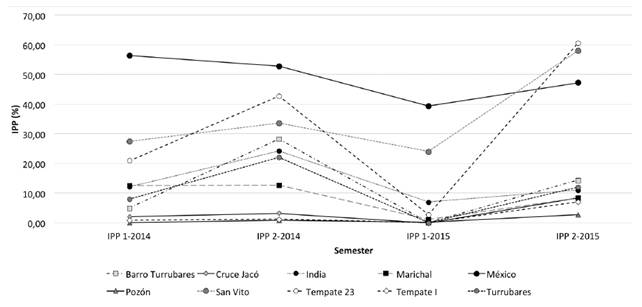
Figure 4 Green fruit production per plant for the accessions during the different time periods studied
No significant differences were found in studies carried out to evaluate reproductive success, comparing plants that were pollinated naturally with those that were artificially pollinated (12).
Reproductive success can be measured through gathering of seeds from flowers exposed to different pollination treatments (10). In this study, success was measured by comparing flower production and fruit yield. Montaldo (9), found that mean reproductive efficiency varied between species, and that the effect of correlations between species and year was not significant.
According to the phenology analysis, inflorescence production began during the months of February and March. The highest production of inflorescences occurs in April, which is the period of highest solar irradiation (MJ/m2), as noted by (13). In addition, rainfall starts in the month of March, which can contribute to increased plant yields in terms of inflorescences and female flowers, leading to a peak in production as shown in figures 1 and 2. However, as with other crops, this response is associated with soil fertility and the plant´s genetic traits (13). These conditions and their relationship to yield have been studied in coffee crops (Coffea arabiga) (14), where it has been reported that during the period of flower budding and branch development (approximately 2 months before the floral anthesis), dry weather conditions, adequate radiation, and high temperatures with considerable daily fluctuation prevail; while during the anthesis period there is a predominance of variable weather conditions and lower temperatures at night. However, while flower blooming and anthesis occur in the periods of highest rainfall and solar radiation under the crop conditions found at the Estación Experimental Fabio Baudrit for Jatropha curcas (jatropha), it is not possible to determine which factor has a greater influence on this development.
A correlation analysis of inflorescence production and temperature (°C), rainfall, and solar radiation (Mj/m2) was performed. Table 4 shows a negative correlation with values of more than 0.40 which were obtained only for production of inflorescences with respect to solar radiation and rainfall.
Table 4 Correlation between climatic variables (solar radiation, rainfall, and temperature) and inflorescence production
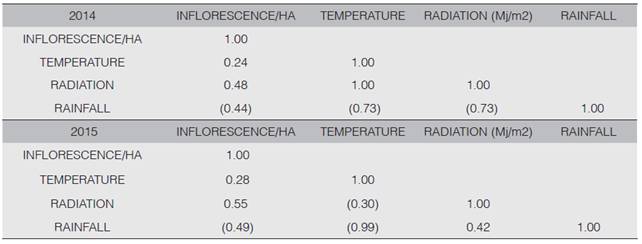
A correlation analysis of the variables of female flower production and temperature (°C), solar radiation (Mj/m2) and rainfall was also carried out. Table 5 shows that there is a negative correlation, and that correlation values of more than 0.40 were only found between female flower production and solar radiation.
Table 5 Correlation between climatic variables (solar radiation, rainfall, and temperature), and female flower production
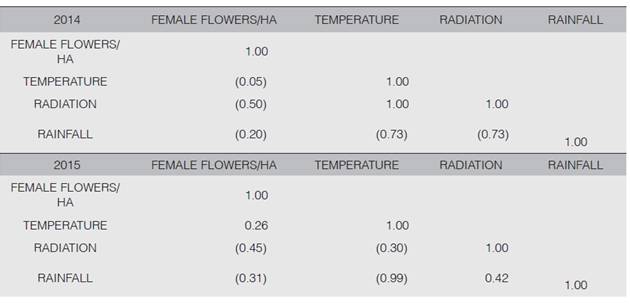
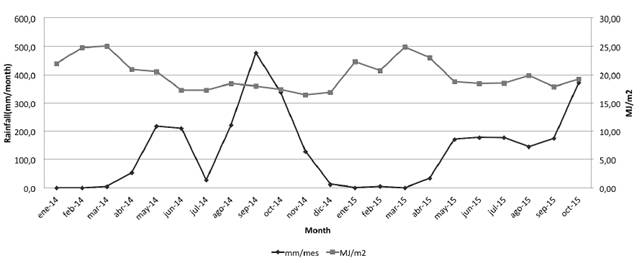
Figure 5 Mean monthly rainfall (mm/month) and average solar radiation (MJ/m2) recorded at the meteorological station of the Estación Experimental Fabio Baudrit
It has been observed in studies of various crops that in order to achieve better flower and fruit production, factors other than those related to climate must be considered, such as nutritional control of the crop. It has been shown that boron is an important microelement that affects different processes such as flowering, size enhancement, fertility and germination of pollen, growth of pollination tubes, increases in levels of nectar to make flowers more attractive to bees, positive effects on seed development, and enhanced fruit quality. Therefore the use of boron along with molybdenum several days prior to the start of the flowering stage helps to improve the crop harvest (15). Low doses of nitrogen and other nutritional factors also promote plant flowering (16).
It has been shown that light intensity and duration, along with seasonal changes and daily temperature fluctuation, as well as other environmental and genetic factors, have an impact on the plant’s development cycle (16).
The development process, from the stage of flower blooming to fruit ripening, takes approximately three months (17). The reduced fruit harvest is due to the small amount of female flowers per inflorescence, which, on average, ranges between 0-10 female flowers (17) (1).













